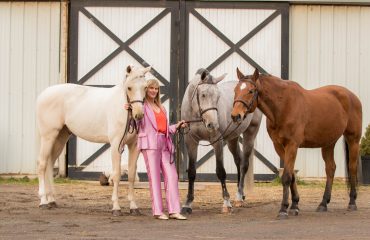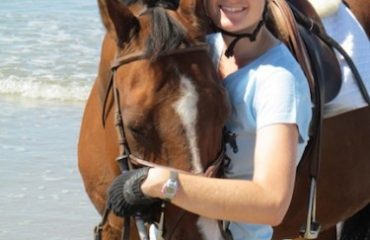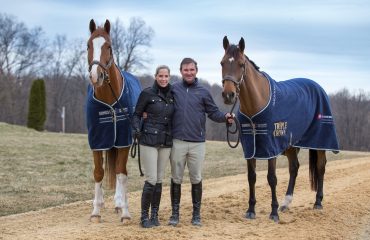
The O’Mara Family
Photo courtesy of Tom O’Mara
By Doris Degner-Foster
When Tom O’Mara had the opportunity to help save the National Collegiate Athletic Association Equestrian Teams from possibly coming to an end in 2014, he was happy to step up.
As a horse show dad who has followed his four kids — and wife — up and down the East Coast as they participated in shows from Pony Finals to the ASPCA Maclay for the last 15 years, Tom knows a little something about horses, kids and showing. In fact, Tom’s youngest child, TJ, carried the torch through the equitation ring in 2016, finishing the year by winning both the Platinum Performance/USEF Show Jumping Talent Search Finals East and the Pessoa/US Hunter Seat Medal Final — won by his sister Meg four years earlier.
“We couldn’t have imagined a better finish to many years of finals,” Tom said. “It really was a great finish to all the years of Big Eq Finals we survived as a family. TJ’s success in his final year was something we really shared together. Our family chats during his rounds were hysterical … let’s just say there were both nerves and nails being chewed! It was like they were all in the ring again, Casey, Abby and Meg. TJ has looked up to his sisters as riders he one day wanted to be and I think his performance was as much for them, for all the support they’ve given him over the years, as anything … he was always open to their advice and listened.”
While winning finals is something to celebrate in the O’Mara family, for Tom, there is much more value. “I believe the greatest benefit my children have all gotten from their involvement with horses and riding has nothing to do with the ribbons won, but with learning about discipline, commitment, effort, humility, self-confidence and attitude,” Tom said. “A good solid dose of all of them makes you not only a better rider, but a better person.”

Tom and his son TJ
Photo courtesy of Tom O’Mara
As his children began to consider different colleges, he was just as involved and interested in the programs available for them to ride as college students. “I’ve always been an avid collegiate sports fan,” Tom said. “When my children reached the college years, seeing so many opportunities opened to them because of their years of riding was really unexpected, and something we’re so thankful for.” He found that there were numerous formats for riding while in college offering many opportunities for all levels of riding, such as the Intercollegiate Horse Show Association (IHSA). While college teams offer polo, dressage, rodeo and eventing, the best fit for Tom’s daughters was to join the NCAA Equestrian teams.
When Tom heard the rumors that NCAA’s Committee on Women’s Athletics was considering dropping equestrian sports, he was concerned. Because the sport had not yet reached the criteria of 40 participating schools, which is the NCAA requirement of championship status, the existing equestrian teams were in danger of being dropped entirely.
Pitching in To Help
In 2002, the National Collegiate Equestrian Association (NCEA) was created, giving young equestrians in the U.S. the opportunity to compete at the NCAA Division 1 level, and to be a student athlete with the same recognition as members of a college’s well-known football and basketball teams. The original plan was for the members of the NCEA to build the infrastructure and network required to get more colleges and universities to participate. “I recognized that the decision to drop the equestrian program was more of an organizational and management issue than a sport issue,” Tom said, and he became a member of the national advisory board for the NCEA. With over 30 years working for investment banks, Tom felt that as a board member, he could be of help to grow the sport with financial sponsorship.
Tom fully realized the importance of his task as he and other national advisory board members of the NCEA met with its members, who are the college team coaches who manage the day-to-day activities of the sport. It quickly became clear that the coaches were very busy in their full-time jobs of training and managing their compliance with all the rules of the NCAA, and that working to grow the sport wasn’t something they had the time to do. Tom pointed out that with all the other established sports in the NCAA, none of the coaching staff are involved in the growth of their sports — they’re busy being good coaches.
“Members of the national advisory board come from all walks of life and it’s been a great team to be a part of,” Tom said. “I learn so much from them all and we’ve collectively formulated a pretty good roadmap to ensure growth of NCAA Collegiate Equestrian.”
Roadmap For Success
After carefully researching the situation, Tom and other members of the board of the NCEA formulated their argument in favor of equestrian sport. Some major points they brought to the attention of the NCAA were that during the time frame of 2008-13, all collegiate athletic programs were decreasing in number of programs and participants, a reflection of the stagnating economy. Another valid point was that the number of participants in the equestrian sports actually outnumbered other sports that already had championship status and were considered full members of the NCAA.

Tom’s son, TJ, winning the Platinum Performance/USEF Show Jumping Talent Search Finals East.
Photo courtesy of Tom O’Mara
As a result, the NCAA Strategic Vision and Planning Committee tabled the earlier decision to drop equestrian sport. Then the NCAA Division I and Division II Councils both voted strongly in favor of maintaining equestrian as an emerging sport within the NCAA. With that support in place, the NCEA Board of Advisors and members could move forward with their plan to grow the sport.
The plan is ongoing and includes assistance to universities and colleges to add an NCAA equestrian team. The national advisory board members communicate with administrators, athletic departments, veterinary schools, and existing equestrian programs — things that the NCEA members didn’t have the time to do around their coaching and administrative duties.
NCEA members were hampered in their goal of growing the number of participating schools not only because of their demanding duties as team coaches, but also because of NCAA rules. “Given the fact that NCAA rules restrict schools from going out and marketing their programs, it really has come a long way,” Tom said. “But many people still are not fully up to speed on this aspect of collegiate equestrian.”
Equestrian Sport
With equestrian sport having recognition as an NCAA sport — even as “emerging sport” status — it means that each school can offer up to 15 full scholarships, which can be sliced into partial scholarships. For example, 30 students could receive a half scholarship, which could greatly help meet the financial demands of attending college. Team members also enjoy the same perks of other college teams, such as flexibility of class assignments around their sport’s events, tutoring, special academic advising and the validation of being recognized as a member of an official sports team of their college or university. Live streaming is also available at several meets. “It’s a privilege to be a part of the team,” Tom said. “Such recognition helps our sport in innumerable ways and as equestrians, we should all be proud of that and support it!”
While operating under the umbrella of the NCAA, there are guidelines that must be followed regarding publicity, recruiting, sponsorship and advertising. With Tom’s background in finance and fundraising, he’s happy to be able to take that aspect off the already full plate of the NCEA members who are busy coaching and running the other business of their teams.
Participating in sports in college can be rewarding in a number of ways but equestrian sport has more to offer than the average sport. Discipline, commitment and effort are required for all sports but when working with a partner that’s a 1,200-pound animal, it also teaches self-confidence and the proper attitude along with humility. As Tom said, a good dose of all of them makes one a better person as well as a better rider.
It sounds like the perfect formula to help a student be well prepared for life after college.













